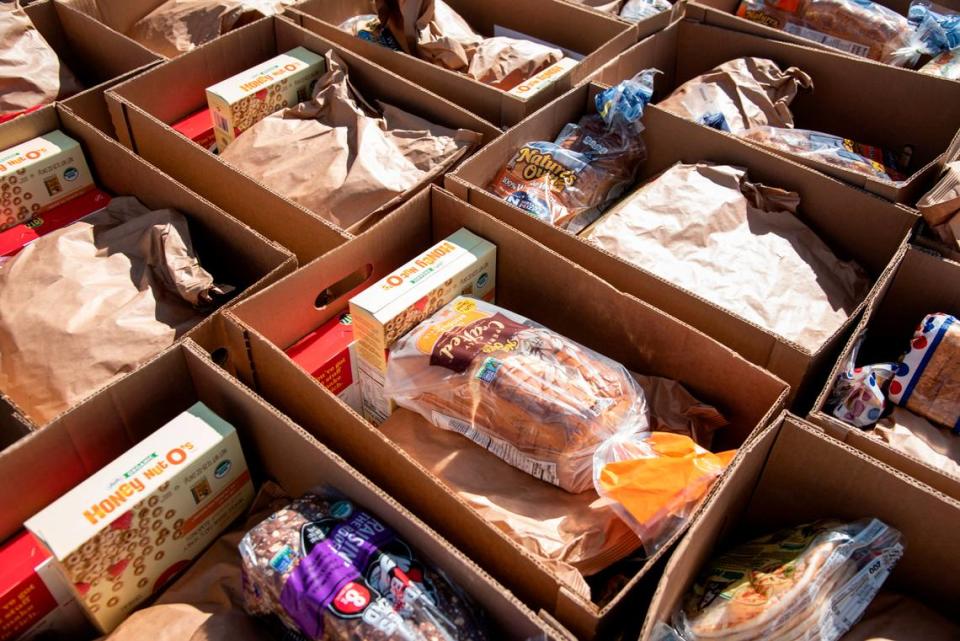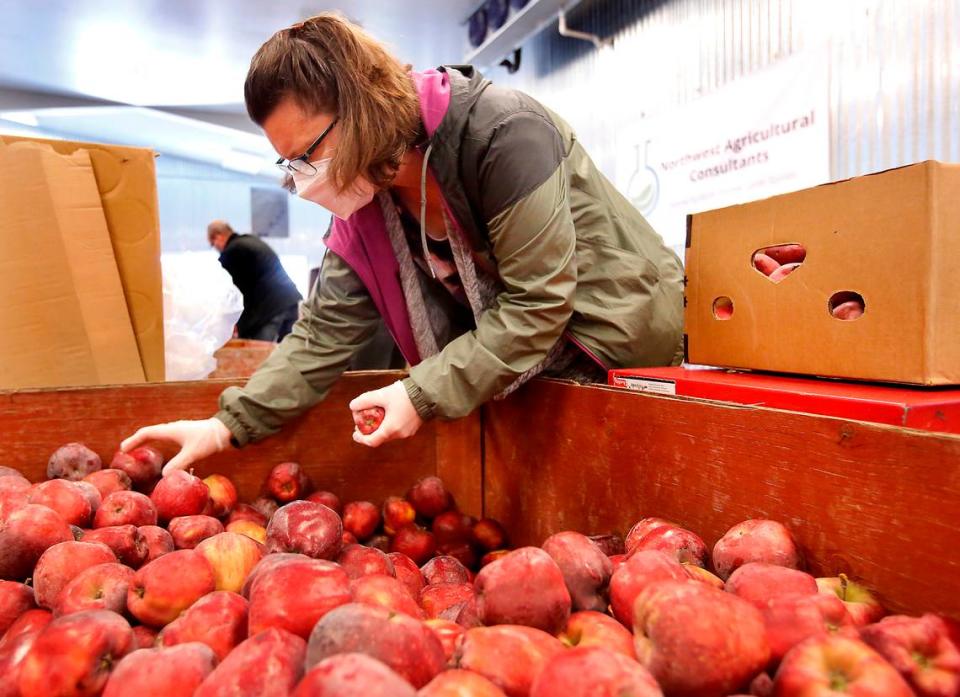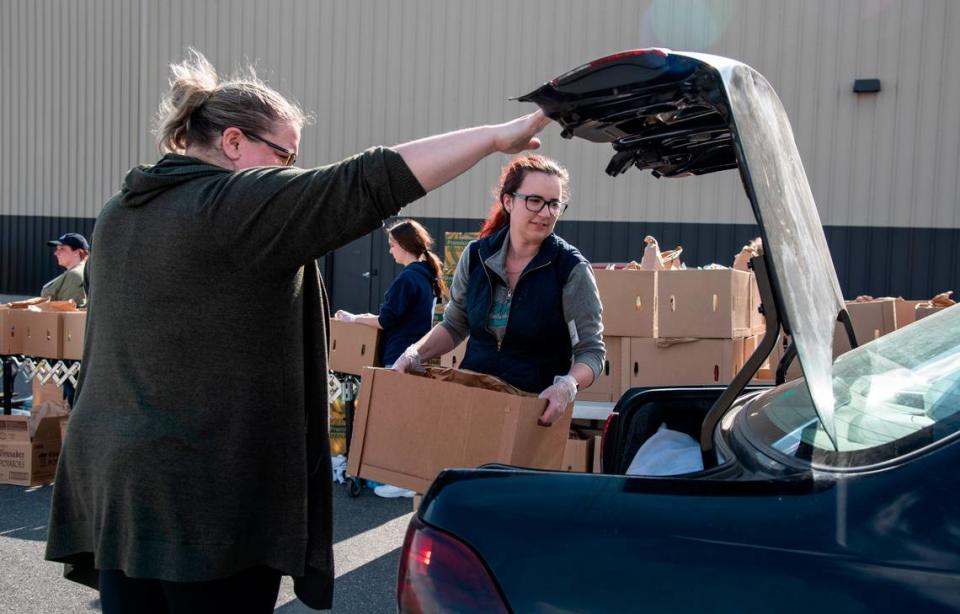Hunger’s ‘perfect storm.’ Cuts in funding leave food banks scrambling to feed Tri-Citians
Eastern Washington food banks and pantries are facing a perfect storm of bad conditions.
Virtually everything that can negatively impact a food bank is hitting at once, with the most severe blow being a more than $1 billion loss in federal funding across Washington state.
That’s left organizations trying to feed hungry Tri-Citians facing growing challenges from every angle.
The number of people who reported being food insecure has grown significantly since last summer, according to a new joint survey by the University of Washington and Washington State University.
How will Tri-Cities hunger agencies manage the growing need as federal funds dry up?
Inflation and funding
Coming into spring, food banks are facing a new challenge: coping with inflation without the billions in federal aid made available during the COVID pandemic.
In Washington and at the federal level, pandemic funding and emergency rules are expiring, but need hasn’t gone down.
Together they are set to create a shortfall in the money that food providers need to meet the increased demand for their services.
Lawmakers estimate the shortfall will come out to about $93 million per month in federal food assistance, across an array of programs.
House Bill 1784, which passed in the state House and is currently being considered in the Senate, would add another $28 million in total from the state’s general fund to help address the problem.
That would leave the state with a full year shortfall of more than a billion dollars.
The changes in federal funding will have the most immediate impact on SNAP recipients.
The emergency allotment program ended with February disbursements, meaning families on SNAP will receive $95 less per person this month, which is estimated to average $170 per household.
About half a million households in the state receive SNAP benefits. Seniors will be most impacted as they received larger than average increases in assistance.

There was also a drop in direct food deliveries from the government.
Second Harvest Community Partnerships Director Eric Williams said that in a normal year the organization gets about 10% of its food from government sources, but that spiked to 40% with pandemic programs.
That surge in direct food donations has largely dissipated, he said.
Supply chain challenges
Food banks and pantries are also finding themselves more reliant on cash donations than ever.
One of the biggest reasons they’ve become increasingly reliant on monetary donations is the long-term impacts of the disruptions to the global and local supply chains in recent years.
Disrupted supply chains for grocers has resulted in stores ordering less food, leading to fewer donations to food banks.
Typically when grocery stores have food nearing “sell-by” dates, they would donate that food to local food banks or food rescue operations.
Because stores are keeping less inventory on hand, donations are coming less frequently, especially for important food groups such as meat and perishable proteins.
Tri-Cities Food Bank Chairman Howard Rickert said that as the global supply chain began experiencing issues, it became harder and harder for grocers to maintain the same level of donations to food banks and pantries.
“Worldwide the situation with the food banks in the post-pandemic world is they’re tied up in the logistics mess everyone else is,”
Rickert said.
“Donated food is becoming less and less, particularly from the large food retailers. Particularly here in the Tri-Cities, grocers in pre-pandemic days had a pretty good amount of food left over or approaching sell-by that was donated,” he said.
Regionally, farmers have had a particularly rough run the last few years, with near record low crop yields for many growers.

Over the past few years, most of Washington’s largest crops have seen decreasing production numbers year over year, according to the USDA. Wheat production was cut nearly in half from 2020 to 2021, for all seasons.
Onions and potatoes also saw year-over-year drops during the same time period, though not as steep as wheat. In 2022 wheat and potato production recovered some, but still fell short of 2020 production levels.
That means farmers, who make up a huge portion of the fresh fruit and vegetable offerings food banks receive, have less to donate, said Second Harvest Community Partnerships Director Eric Williams.
“When farmers, who are very generous, have less to sell, they have less to donate,” Williams said. “We’re simultaneously very concerned about that, but also very grateful for them.”
Second Harvest is a regional distributor for smaller food banks and pantries, which means outside of select events like drive-through holiday meal donations, they don’t directly hand out the food.
He said the concerns seen in the Tri-Cities area are echoed at their pantries across the Eastern Washington.
And within the food bank distribution network itself, the supply chain has had to shift to combat rising gas prices and other costs.
Through distribution hubs in Spokane and Pasco, Second Harvest covers a 26-county region, that includes everything east of the Cascades in Washington and the western-most counties in Idaho, along the Washington border.
Second Harvest said currently it had been running trucks only a third or half full to pantries across the region, which was costing a lot of money and tying up the fleet.
If they needed to be able to send someone out to pick up a load of donated vegetables, a truck might not be available because they were doing a dairy distribution more than 100 miles away.
To help combat that, Williams said they’ve started shifting to more inter-regional distribution methods, allowing pantries to come to centralized locations to pick up what they need.
Recently they began working with a partner for more efficient deliveries in the northern reaches of the state in Colville.
“That was prompted almost completely because we were short on food, our stocks were very low,” Williams said. “We spent an extra $500,000 just to bolster our inventory and that’s all gone through the system.”
“Since then we’ve made a change to our operations model, once a month we take a semi to a place called Rural Resources, then the pantries in that region can come pick up there. We’re working on incorporating that model in South central Washington as well,” he said.
The disruptions to supply chains have left food banks and pantries more reliant on making their own purchases, at a time when buying the food is becoming more of a challenge of its own.
Meanwhile inflation continues to rise, meaning pantries and distributors are getting less bang for their buck.

Volunteer loss
Rickert said that another way to help organizations like the food bank is by volunteering. He said that like the workforce, many people disappeared from volunteer rosters for various reasons.
“What you’re finding is the volunteers are in the same situation as anyone else. It’s a revolving door, they’re hard to find,” Rickert said. “It’s kind of an 80-20 rule. The pandemic caused 20% of our volunteers to leave for health concerns because many are older and disabled or concerned about their health. When the pandemic ended those people didn’t come back.”
Rickert said one thing that has come out of the changes made necessary in the pandemic is safer, more comfortable conditions for volunteers who might still be worried about getting sick.
“People are tired and they’re just rung out, and society changed,” he said. “There’s now much less face-to-face contact, increased safety, the increased handling (precautions), air filtration. It’s really what enabled (organizations) to keep the remaining volunteers they had because they feel safer.”
Food banks and pantries are also having to spend more on storage.
Emergency storage protocols have lapsed and now they’re having to build space for the increased food they need to keep on hand and the increased local purchasing of bulk foods.
“We’re making it work,” Rickert said.

